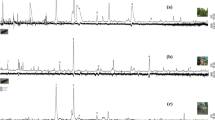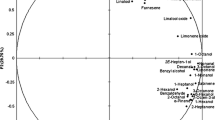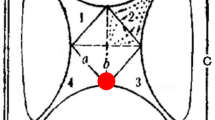Abstract
Volatiles were extracted from rice plants of various growth stages with solid-phase microextraction (SPME) and analyzed by gas chromatography-mass spectrometry (GC-MS) to identify attractants that cause invasion of the rice leaf bug Trigonotylus caelestialium (Kirkaldy) into paddy fields. The composition of volatile blends produced by rice plants changed with rice development. In addition, volatile blend compositions differed between the panicles and the stems and leaves. The relative geranyl acetone content was high in all plant structures analyzed. In volatiles from whole plants in the fourth-leaf stage and panicles in the full-ripe stage, the relative content of green leaf volatiles (GLVs) was higher than that found in other rice plant structures. In contrast, relative terpene levels emitted from whole plants in the panicle-formation stage and by panicles and stems and leaves in the flowering stage were higher than those of other rice plant structures. However, the type of terpenes found differed between the panicles and the stems and leaves. Relative levels of β-caryophyllene in whole plants in the panicle-formation stage and panicles in the flowering stage were much higher than that in stems and leaves in the flowering stage. Our previous studies demonstrated that the odor from whole plants in the panicle-formation stage and panicles in the flowering stage is attractive to rice leaf bugs. Here, the attractiveness of β-caryophyllene to adult bugs was investigated in olfactometer assays. Adult females were attracted to β-caryophyllene at a concentration of 0.001%, which is approximately equivalent to the concentration produced by flowering rice panicles. However, β-caryophyllene also was present in the odor of whole plants in the fourth-leaf stage and in stems and leaves in the flowering stage. Furthermore, the amounts of this compound emitted from these structures were similar. Therefore, we suggest that the relative abundance of this compound in a volatile blend is important for attractance of the bugs.

Similar content being viewed by others
References
Adams, R. P. 2001. Identification of essential oil components by gas chromatography/quadrupole mass spectroscopy. P. 456. Allured Publishing Co., Carol Stream.
Asaro, C., Sullivan, B. T., Dalusky, M. J., and Berisford, C. W. 2004. Volatiles associated with preferred and nonpreferred hosts of the Nantucket pine tip moth, Rhyacionia frustrana. J. Chem. Ecol. 30:977–990.
Bertoli, A., Pistelli, L., Morelli, I., Fraternale, D., Giamperi, L., and Ricci, D. 2004. Volatile constituents of different parts (roots, stems and leaves) of Smyrnium olusatrum L. Flavour Fragr. J. 19:522–525.
Blackmer, J. L., Rodriguez-saona, C., Byers, J. A., Shope, K. L., and Smith, J. P. 2004. Behavioral response of Lygus hesperus to conspecifics and headspace volatiles of alfalfa in a Y-tube olfactometer. J. Chem. Ecol. 30:1547–1564.
Campbell, C. A. M., Pettersson, J., Pickett, J. A., Wadhams, L. J., and Woodcock, C. M. 1993. Spring migration of damson-hop aphid, Phorodon humuli (Homoptera, Aphididae), and summer host plant-derived semiochemicals released on feeding. J. Chem. Ecol. 19:1569–1576.
Deng, C., Zhang, X., Zhu, W., and Qian, J. 2004. Gas chromatography-mass spectorometry with solid-phase microextraction method for determination of methyl salicylate and other volatile compounds in leaves of Lycopersicon esculentum. Anal. Bioanal. Chem. 378:518–522.
Fujii, T., Hori, M., and Matsuda, K. 2010. Influence of host plant odours on invasion of the rice leaf bug Trigonotylus caelestialium into paddy fields. Agric. Forest Entomol. 12:99–105.
Groot, A. T., Heijoer, A., Visser, J. H., and Dicke, M. 2003. Oviposition preference of Lygocoris pabulinus (Het., Miridae) in relation to plants and conspecifics. J. Appl. Entomol. 127:65–71.
Hachiya, K. 1999. Migration of rice leaf bug, Trigonotylus caelestialium (Kirkaldy) into rice fields and forecasting of the abundance. Plant Prot. 53:268–272 (in Japanese).
Hammack, L. 2001. Single and blended maize volatiles as attractants for diabroticite corn rootworm beetles. J. Chem. Ecol. 27:1373–1390.
Harper, J. K., Way, M. O., Dress, B. M., Rister, M. E., and Mjelde, J. W. 1993. Damage function analysis for the rice stink bug (Hemiptera: Pentatomidae). J. Econ. Entomol. 86:1250–1258.
Higuchi, H., Takahashi, A., and Mima, J. 2001. Grasses used as host plants on oviposition by rice leaf bug, Trigonotylus caelestialium (Kirkaldy) (Heteroptera: Miridae), in autumn. Proc. Assoc. Plant Prot. Hokuriku. 49:15–17 (in Japanese).
Hori, M. 1998. Repellency of rosemary oil against Myzus persicae in a laboratory and in a screenhouse. J. Chem. Ecol. 24:1425–1432.
Hori, M. 1999. Role of host plant odors in the host finding behaviors of aphids. Appl. Entomol. Zool. 34:293–298.
Hori, M. 2009. Olfactory response of Stenotus rubrovittatus to rice and paddy weed, Scirpus juncoides. J. Appl. Entomol. 133:438–443.
Hori, M., Ohuchi, K., and Matsuda, K. 2006. Role of host plant volatile in the host-finding behaviour of the strawberry leaf beetle, Galerucella vittaticollis Baly (Coleoptera: Chrysomelidae). Appl. Entomol. Zool. 41:357–363.
Ishimoto, M. 2004. Seasonal prevalence of occurrence of the rice leaf bug, Trigonotylus caelestialium (Kirkaldy) (Heteroptera: Miridae) on paddy rice plants. Jan. J. Appl. Entomol. Zool. 48:79–85 (in Japanese with English summary).
Jahn, G. C., Domingo, I., Almazan, M. L. P., and Pacia J. 2004. Effect of rice bug Leptocorisa oratorius (Hemiptera: Alydidae) on rice yield, grain quality, and seed viability. J. Econ. Entomol. 97:1923–1927.
Kainoh, Y., Shimizu, K., Maru, S., and Tamaki, Y. 1980. Host-finding behavior of the rice bug, Leptocorisa chinensis Dallas (Hemiptera: Coreidae), with special reference to diel patterns of aggregation and feeding on rice plant. Appl. Entomol. Zool. 15:225–233.
Khalilova, A. Z., Paramonov, E. A., Odinokov, V. N., and Khalilov, L. M. 1998. Identification and biological activity of volatile organic substances emitted by plants and insects. I. Components of the native scents of Leptinotarsa decemlineata and Solanum tuberosum. Chem. Nat. Comp. 34:647–649.
Kikuchi, A., and Kobayashi, T. 2003. Preference to spring gramineous weeds and Italian rye grass as food of Trigonotylus caelestialium (Kirkaldy) (Heteroptera: Miridae). Annu. Rep. Plant. Prot. North Japan. 54:113–114 (in Japanese).
Lou, Y., Ma, B., and Cheng, J. 2005. Attraction of the parasitoid Anagrus nilaparvatatae to rice volatile induced by the rice brown planthopper Nilaparvata lugens. J. Chem. Ecol. 31:2357–2372.
Minyard, J. P., Hardee, D. D., Gueldner, R. C., Thompson, A. C., Wiygul, G., and Hedin, P. A. 1969. Constituents of the cotton bud. Compounds attractive to the boll weevil. J. Agric. Food Chem. 17:1093–1097.
Nakasuji, F. 1973. The characteristics of occurrence of rice bugs and the control threshold. Plant Prot. 27:372–378 (in Japanese).
Niiyama, T., Fujii, T., Hori, M., and Matsuda, K. 2007. Olfactory response of Trigonotylus caelestialium (Heteroptera: Miridae) to rice plant and gramineous weeds. J. Appl. Entomol. 131:513–517.
Nojima, S., Linn, Jr. C., Morris, B., Zhang, A., and Roelofs, W. 2003. Identification of host plant volatiles from hawthorn (Crataegus spp.) attractive to hawthorn-origin Rhagoletis pomonella flies. J. Chem. Ecol.29: 321–336.
Okuyama, S. 1974. Life history of the rice leaf bug (Trigonotylus caelestialium Kirkaldy) 1. Seasonal prevalence of occurrence. Annu. Rep. Plant Prot. North Japan. 25:53 (in Japanese).
Rashid, T., Johnson, D.T., and Bernhardt, J. L. 2006. Sampling rice stink bug (Hemiotera: Pentatomidae) in and around rice fields. Environ. Entomol. 35:102–111.
Sakuma, M., and Fukami, H. 1985. The linear track olfactometer: an bioassay device for taxes of the german cockroach, Blattella germanica (L.) (Dictyoptera: Blattellidae) toward their aggregation pheromone. Appl. Entomol. Zool. 20:387–402.
Takeuchi, H., Watanabe, T., and Suzuki, Y. 2004. Species-specific feeding marks of stink bugs on rice grain in Leptocorisa chinensis Dallas (Hemiptera: Alydidae), Lagynotomus elongatus (Dallas) (Hemiptera: Pentatomidae) and Cletus punctiger (Dallas) (Hemiptera: Coreidae). Jpn. J. Appl. Entomol. Zool. 48:39–47 (in Japanese with English summary).
Tasin, M., Bäckman, A.-C., Bengtsson, M., Claudio, I., and Witzgall, P. 2006. Essential host plant cues in the grapevine moth. Naturwissenschaften. 93:141–144.
Tasin, M., Bäckman, A.-C., Corasini, M., Casado, D., Ioriatti, C., and Witzgall, P. 2007. Synergism and redundancy in a plant volatile blend attracting grapevine moth females. Phytochemistry 68:203–209.
Visser, J. H. 1986. Host odor perception in phytophagous insects. Annu. Rev. Entomol. 31:121–144.
Watanabe, T., and Higuchi, H. 2006. Recent occurrence and problem of rice bugs. Plant Prot. 60:201–203 (in Japanese).
Weissbecker, B., Van Loon, J. J. A., Posthumus, M. A., Bouwmeester, H. J., and Dicke, M. 2000. Identification of volatile potato sesquiterpenoids and their olfactory detection by the two-spotted stink bug Perillus bioculatus. J. Chem. Ecol. 26:1433–1445.
Wheeler, A. G. 2001. Biology of the Plant Bugs. 507 p. Cornell University Press, New York.
Wheeler, A. G., and Henry, T. J. 1985. Trigonotylus caelestialium (Heteroptera: Miridae), a pest of small grains: seasonal history, host plants, damage, and descriptions of adult and nymphal stages. Proc. Entomol. Soc. Wash. 87:699–713.
Acknowledgements
We wish to thank Zeon Co. and Nippon Terpene Chemicals Inc. for kindly supplying authentic compounds. This work was supported by a Grant-in-Aid for Scientific Research (C) from the Japan Society for Promotion of Science.
Author information
Authors and Affiliations
Corresponding author
Rights and permissions
About this article
Cite this article
Fujii, T., Hori, M. & Matsuda, K. Attractants for Rice Leaf Bug, Trigonotylus caelestialium (Kirkaldy), are Emitted from Flowering Rice Panicles. J Chem Ecol 36, 999–1005 (2010). https://doi.org/10.1007/s10886-010-9839-6
Received:
Revised:
Accepted:
Published:
Issue Date:
DOI: https://doi.org/10.1007/s10886-010-9839-6




